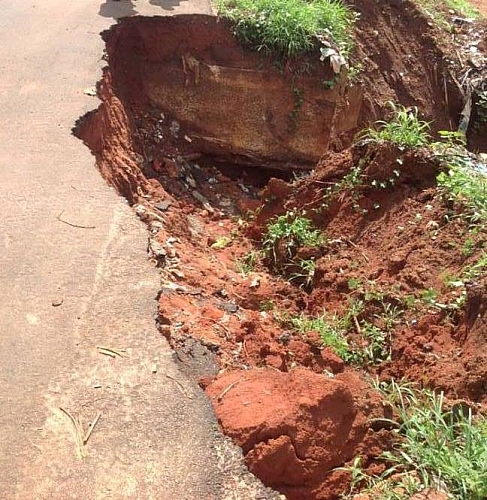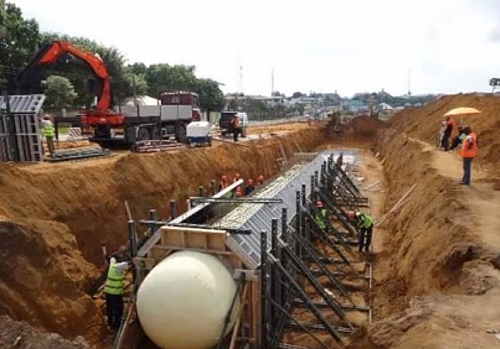Gully erosion is defined as the removal of the top soil along drainage channels by surface water runoff; it is the type of soil erosion that consists of an open, incised and unstable channel generally more than 30cm deep. Gully erosion may occur as a result activity of man on the land surface such as tin mining, construction, grazing, deforestation and farming activities. Gully erosion may begin at a small area of land and will continue to move by headward erosion or by slumping of the sidewalls until it has taken over a large portion of land. Gully erosion highly occurs most in area where the contributing effects of land use, climate change and slope interact are prominent.
Table of Contents
Causes of gully erosion
Causes of gully erosion include:
- Gully erosion may occur as a result of continuous and heavy rainfall- The greater the intensity and duration of a rainfall, the higher the erosion potential. The impact of raindrops on the soil surface can break down soil sediments and disperse the sediment to down streams.
- It may occur as a result of poor ground cover caused by bush clearing, bush burning, high stocking rates, repeated cultivations, rabbits and other burrowing animal
- Gully erosion caused by mining activities- mining is usually carried out on the earth surface for the purpose of extracting gold, tin ore and other useful minerals; during the mining process, artificial gullies are created which are visible on a large expanse of land. Such pits are dangerous and they serve as death traps to many lives. Example of artificial gullies created as a result of mining activity are the cases of Jos city (the tin city) and its environs in Nigeria.
- Gully erosion is also caused by farming and uncontrolled grazing practises- When a farmland is continuously tilled or grazed without a break, it breaks up soil and softens the overall structure thus reducing the organic matter content of the soil, which eventually allows the soil to become susceptible to the effects of rain and running water.
- Deforestation the act of falling trees without replacement due to increasing land demand have in so many ways resulted in enhancing extent of gully erosion. Deforestation is the actual cause of gully erosion in many parts of the world, as tree roots are good at binding the top layer of the soil in place.
- Concentrated runoff from steep lands flowing into cleared drainage depressions- the steeper slope, the lesser the infiltration of water hence, soil erodes more on steeper slopes than on grounds that have mild slope; this happens more on area where there is increase speed of run off.
- Unstable soils in drainage lines- Lighter particles of soil such as very fine sand, silt, clay and organic matter are easily removed by the rain splash and runoff water; for move larger sand and gravel particles to be washed away, heavy raindrops and heavy flow of run off are required.
- Elevated runoff is caused by low levels of tree cover or barren land, which results to poor soil infiltration.
Effect of gully erosion
- Loss of farmland: gully erosion brings about reduction of arable farmland; it also reduces the quality of crops grown on such areas. Over the years, vast area of farmlands has been lost to gully erosion while others are at their various stages of destruction, which may later lead to drastic decrease in agricultural productivity and food shortage thus, resulting to famine.
- Loss of organic matter form the soil: continuous gully erosion will eventually lead to loss of nutrients and organic matter which will eventually prevent plants from surviving in the affected areas.
- Pollution of ecosystem: the materials that are washed away from farms and fields usually settle somewhere, and one of such places is in streams, rivers or on an empty land. Soil washed into a river can alter the natural course of the waterway, change the natural colour of water, changing its depth and even forcing the water into a new path over time. Worse of all, much of the topsoil that is washed away from agricultural operations is rich in nitrogen-based fertilizers, this can combine with other nutrients in the water to supportalgae blooms.
- Threat to natural ecosystem: gully erosion has resulted in loss of vegetation as its continuous expansion encroaches into the natural forest; this is mostly caused by high land demand by increasing population, which eventually leads to falling of trees for construction as a result of this, the surface of the soil is continuously exposed to gully erosion. The phenomenon if allowed to continue and remains unchecked may ultimately lead to climatic changes locally or globally.
- Destruction of valuable properties: several properties like houses, electric poles, telecommunication masks and water pipes located near the affected areas are destroyed due to gully erosion, others are under treat by this menace especially houses, and other properties located on the floodplain.
- Effect on human life: Many lives have been lost as a result of the problem of gully erosion. Some people (both young and old) have sometime fallen into these gullies and sustained various degrees of injury or died. Some instances have also been reported where people are drowned in some of the gully sites; while thousands of people have been displaced and evacuated their homes following the gully incidences.
- Effect on rural and urban linkages:Gully erosion has resulted in the separation of adjacent villages and towns as it may involve collapse of the bridges linking them together. This has had negative impacts on such areas since some facilities such as schools, hospitals and water supplies shared by the affected neighbouring communities may become inaccessible. Transportation of farm produce has also been affected and this often leads to loss of agricultural products especially the perishable ones. Traders who also go to these areas for their trade are also cut off from their normal day-to-day business.
- Bad Land:Gully erosion has given rise to infertile and barren land; significant amounts of land have been taken out of production, this could further create hazardous condition for the inhabitants as any available motor able road will be blocked or damaged and mayno longer be accessible in such areas.
How to control gully erosion/ preventive measures
- The there are many ways to prevent gully erosion and a good way to do this is to plant cover crops to reduce surface run off and soil loss.
- Areas that experiences gully erosion are advice to construct check dams across the gully bed to stop channel and lateral erosion and stones should be laid across the gully area to form a gradual slope to the downstream side of thedam.
- Brush check dams can be built across the gully by driving wooden pegs into the ground and then intertwining bush-wood along the pegs, by doing this, silt will be trapped behind the dam.
- In areas with high slope and heavy rainfall, a stronger structure may be necessary. Gabions are wire woven baskets filled with stones, and can be placed across the gully area.
- Land use can be changed into a different use, especially in certain areas experiencing gully erosion. For instance, if the land was initially used for grazing, it should be allowed to revert to native vegetation to allow organic matter to build up. In other cases, it may be necessary to stop any further cultivation and keep the areas only for a longer period to retain back its natural state.
- Divert flowing water away from erosion prone areas by constructing culverts or runoff pipes to channel and reduce the force of running water to elsewhere.
- Trees should be planted in strips across the gully sites to reduce the velocity of water, trap silt, and to prevent further erosion from occurring.



